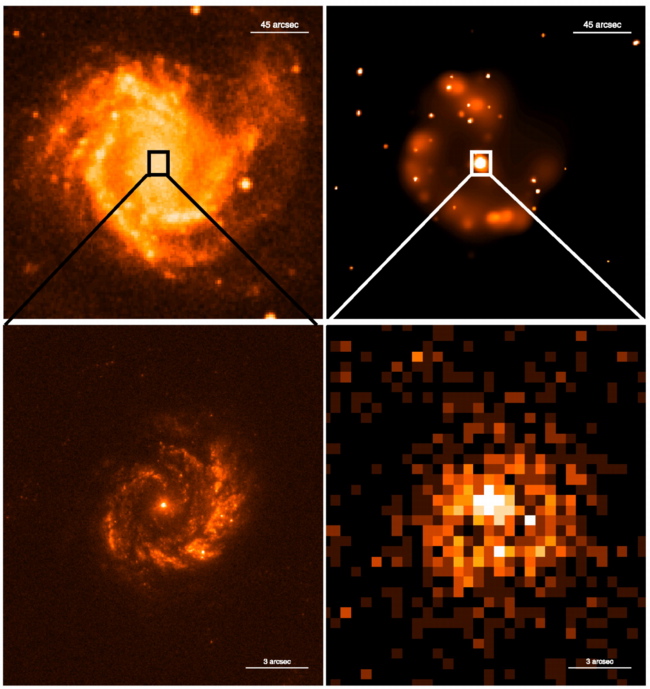
 Credit: X-ray: E. Jiménez-Bailón et al., 2003, The Astrophysical Journal, vol. 593, pg. 127; UV: L. Colina et al.,
2002, The Astrophysical Journal, vol. 579, pg. 545; Optical: Digitized Sky Survey, Space Telescope Science Institute, AAO, UK-PPARC, ROE, National Geographic Society, and California Institude of Technology
Credit: X-ray: E. Jiménez-Bailón et al., 2003, The Astrophysical Journal, vol. 593, pg. 127; UV: L. Colina et al.,
2002, The Astrophysical Journal, vol. 579, pg. 545; Optical: Digitized Sky Survey, Space Telescope Science Institute, AAO, UK-PPARC, ROE, National Geographic Society, and California Institude of Technology
The Star-AGN Connection
The centers of "active" galaxies (active galactic nuclei, or AGN) are thought to house supermassive black holes responsible for the observed "activity". But not all active galaxies are equally active. Some are rather inactive possibly as a result of the central black hole being hidden from our view by a thick disk of material around the black hole. However these AGN often emit unusually large amounts of X-rays. A relatively nearby AGN, NGC 4303 (alias M61) is allowing astronomers to dissect its optical and X-ray emission. The image above left shows the optical emission from the galaxy (top) and UV emission from the center of the galaxy (bottom). On the right is shown an X-ray image of NGC 4303 and its central region obtained by the Chandra X-ray Observatory. Chandra found a source of hard X-rays near the center of the galaxy which might be generated by a central black hole; alternatively these observations might be explained by emission from a cluster of very massive stars along with so-called "ultra-luminous X-ray sources", which could be the precursors of a "supermassive" black hole forming at the galaxy's center. Perhaps NGC 4303 is not (yet?) really an AGN?
Last Week *
HEA Dictionary * Archive
* Search HEAPOW
* Education
Each week the HEASARC
brings you new, exciting and beautiful images from X-ray and Gamma ray
astronomy. Check back each week and be sure to check out the HEAPOW archive!
Page Author: Dr. Michael F. Corcoran
Last modified Monday, 26-Feb-2024 17:11:09 EST


